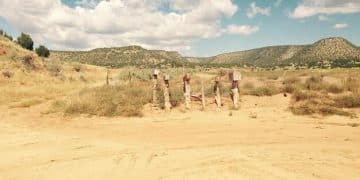The Battle of the Bulge: Weather’s Impact on Outcome

The Battle of the Bulge’s outcome was significantly impacted by unforeseen and harsh weather conditions, which hindered Allied air support and mobility, while initially favoring the German offensive tactics.
The Battle of the Bulge, a critical moment in World War II, was profoundly influenced by the weather. The question of The Battle of the Bulge: How Did Weather Conditions Impact the Outcome? is crucial to understanding the battle’s dynamics.
The Onset of Winter and German Preparations
The Battle of the Bulge, launched in December 1944, occurred during one of the coldest and harshest winters Europe had experienced in years. This timing was no coincidence; the German High Command strategically chose this period to exploit the anticipated weather conditions.
The German planners were well aware that a thick blanket of fog and snow would neutralize the Allies’ superior air power. They hoped that poor visibility would ground Allied aircraft, preventing them from providing crucial reconnaissance and tactical support to ground forces. Furthermore, the frozen ground, while presenting its own challenges, would allow German armor to move more freely through the rugged terrain of the Ardennes forest.
Exploiting Weather for Tactical Advantage
The German strategy hinged on turning the adverse weather into a tactical advantage. By launching their offensive during a period of expected poor visibility, they sought to negate the Allies’ aerial superiority, a key factor in previous Allied successes. This calculated gamble underscored the importance of weather forecasting and its potential impact on military operations.
- German planners anticipated heavy fog and snow to ground Allied aircraft.
- Frozen ground was expected to facilitate the movement of German armor.
- The element of surprise was enhanced by the difficulty of Allied reconnaissance in poor weather.
Ultimately, the Germans aimed to create a window of opportunity in which their ground forces could advance rapidly, disrupt Allied lines, and seize key strategic objectives before the weather improved and the Allies could bring their full air power to bear.
In summary, the winter conditions were not merely a backdrop to the Battle of the Bulge but a strategic element carefully considered and exploited by the German forces in their initial planning and execution of the offensive.
Initial Impact on Allied Forces
The harsh winter weather had an immediate and significant impact on the Allied forces at the start of the Battle of the Bulge. The thick fog, heavy snowfall, and freezing temperatures hampered virtually every aspect of their operations, from reconnaissance to resupply.
The most immediate effect was the grounding of Allied aircraft. The fog and low cloud cover made it impossible for Allied pilots to conduct effective reconnaissance missions, leaving ground commanders with limited information about the size and disposition of the attacking German forces. This lack of situational awareness compounded the element of surprise achieved by the Germans.

Hindered Mobility and Disrupted Supply Lines
The weather also severely restricted the mobility of Allied ground forces. Snow-covered roads and icy conditions made it difficult to move troops and equipment, delaying reinforcements and hindering counterattacks. The challenging terrain of the Ardennes, already difficult to navigate, became even more treacherous under the weight of snow and ice.
Furthermore, the harsh weather disrupted Allied supply lines. Roads became impassable, and the movement of essential supplies, such as ammunition, fuel, and food, was significantly delayed. This logistical strain put added pressure on Allied troops, who were already facing a fierce enemy in extremely challenging conditions.
- Allied aircraft were grounded due to fog and low cloud cover.
- Ground mobility was severely restricted by snow and ice.
- Supply lines were disrupted, leading to shortages of essential supplies.
In conclusion, the initial impact of the harsh winter weather was to create a perfect storm of challenges for the Allied forces, limiting their ability to respond effectively to the German offensive and contributing to the early setbacks they experienced in the Battle of the Bulge.
German Exploitation of Weather Conditions
The German forces strategically exploited the adverse weather conditions to their advantage during the initial phase of the Battle of the Bulge. Their offensive was timed to coincide with a period of anticipated poor visibility, which helped to mask their movements and negate Allied air superiority.
Exploiting the element of surprise was paramount to the German strategy. The thick fog, snow, and low cloud cover made it difficult for Allied reconnaissance planes to detect the buildup of German forces along the front lines. This lack of early warning allowed the Germans to launch their attack with a significant element of surprise.
Armor and Infantry Tactics in Winter Conditions
The frozen ground, while presenting its own challenges, also facilitated the movement of German armor. Tanks and other armored vehicles were able to navigate the otherwise difficult terrain of the Ardennes with greater ease. However, the extreme cold also took a toll on vehicles, causing mechanical failures and requiring extensive maintenance.
German infantry tactics were also adapted to the winter conditions. Soldiers were equipped with winter gear and trained to operate in cold weather environments. However, the extreme cold still caused significant hardship, leading to cases of frostbite, hypothermia, and decreased combat effectiveness.
- The German offensive was timed to coincide with poor visibility.
- Frozen ground facilitated the movement of German armor.
- Infantry tactics were adapted to operate in cold weather environments.
Despite these adaptations, the weather conditions also posed challenges for the German forces. The extreme cold, snow, and fog hampered their own logistics and communications, and the difficult terrain slowed their advance. However, the initial advantage gained by exploiting the weather conditions proved crucial in the early stages of the battle.
In synthesis, the German forces effectively turned the adverse weather conditions into a tactical advantage, exploiting the fog, snow, and frozen ground to mask their movements, negate Allied air superiority, and launch a surprise offensive.
The Turning Tide: Clearing Skies and Allied Response
The prolonged period of adverse weather conditions that initially favored the German offensive in the Battle of the Bulge could not last indefinitely. Eventually, the weather began to clear, and the skies opened, allowing the Allies to bring their full air power to bear on the battlefield.
The clearing skies marked a turning point in the Battle of the Bulge. Allied aircraft, which had been grounded for days, took to the skies in force, providing crucial reconnaissance, tactical support, and air interdiction capabilities. This sudden shift in air superiority had a dramatic impact on the overall course of the battle.

Allied Air Superiority and Tactical Impact
Allied pilots were able to locate and target German armor columns, artillery positions, and supply lines, disrupting the German advance and inflicting heavy casualties. The air attacks also helped to relieve pressure on Allied ground forces, who had been fighting desperately against overwhelming odds.
Furthermore, the improved weather conditions allowed the Allies to resupply their troops more effectively. Convoys of trucks and aircraft were able to deliver much-needed ammunition, fuel, food, and medical supplies to the front lines, bolstering the morale and combat effectiveness of Allied soldiers.
- Clearing skies allowed Allied aircraft to provide crucial support.
- Air attacks disrupted German armor and supply lines.
- Improved weather facilitated the resupply of Allied troops.
Despite the improved weather conditions, the fighting remained intense and brutal. The Germans continued to resist fiercely, and the difficult terrain made it challenging for Allied forces to maneuver and advance. However, the shift in air superiority and the improved resupply efforts gave the Allies a decisive advantage.
In brief, the clearing skies and the subsequent Allied response marked a turning tide in the Battle of the Bulge, allowing the Allies to bring their full air power to bear, disrupt the German offensive, and ultimately regain the initiative.
Logistical Challenges and the Impact on Both Sides
Beyond tactical maneuvers and combat operations, the Battle of the Bulge presented immense logistical challenges for both sides, exacerbated by the harsh winter weather. The ability to maintain supply lines, provide adequate provisions, and evacuate the wounded became a critical factor in determining the outcome of the battle.
For the Allied forces, the initial German advance disrupted established supply routes, leading to shortages of ammunition, fuel, food, and medical supplies. The snow-covered roads and icy conditions made it difficult to transport these essential items to the front lines, and the constant threat of German ambushes made the logistical situation even more precarious.
Strained Supply Lines and Resourcefulness
The Allied logistical challenges were further compounded by the sheer scale of the battle. Hundreds of thousands of soldiers were engaged in combat across a wide front, requiring a massive and constant flow of supplies. Despite these difficulties, Allied logisticians worked tirelessly to maintain supply lines, improvising routes, utilizing air transport, and relying on the resourcefulness of their troops.
The German forces also faced significant logistical challenges during the Battle of the Bulge. Their offensive was predicated on a rapid advance, which required a constant flow of supplies to keep pace with their advancing troops. However, the difficult terrain, the harsh weather, and the disruption caused by Allied air attacks made it increasingly difficult to maintain supply lines.
- Allied supply lines were disrupted by the German advance.
- German supply lines were strained by the rapid advance and Allied air attacks.
- Both sides faced challenges in evacuating the wounded and providing medical care.
The logistical challenges had a direct impact on the combat effectiveness of both sides. Shortages of ammunition and fuel limited the ability of troops to fight effectively, while inadequate medical supplies led to increased casualties. The side that could overcome these challenges and maintain its logistical support would ultimately have a decisive advantage.
Finally, the logistical challenges posed by the winter weather and the scale of the Battle of the Bulge tested the limits of both sides, highlighting the critical importance of logistics in modern warfare.
Long-Term Consequences of the Weather Conditions
The weather conditions during the Battle of the Bulge not only influenced the immediate course of the battle but also had long-term consequences for the soldiers involved, the overall outcome of the war, and the lessons learned for future military operations.
For the soldiers who fought in the Battle of the Bulge, the harsh winter weather left a lasting scar. Many suffered from frostbite, hypothermia, and other cold-related injuries, which had long-term health consequences. The psychological impact of enduring such extreme conditions also took a toll on the mental health of many veterans.
Impact on War’s Progression and Future Tactics
The weather conditions also influenced the overall outcome of the war. The initial German success in exploiting the weather conditions to launch a surprise offensive prolonged the war in Europe and inflicted heavy casualties on both sides. However, the eventual Allied victory in the Battle of the Bulge marked a turning point in the war, paving the way for the final defeat of Nazi Germany.
The Battle of the Bulge also provided valuable lessons for future military operations. Military planners learned the importance of considering weather conditions in strategic planning, the need for adequate winter gear and training, and the critical role of logistics in sustaining operations in harsh environments.
- Harsh weather left lasting physical and psychological scars on veterans.
- The battle influenced the overall outcome of World War II.
- Valuable lessons were learned for future military operations.
In retrospect, the Battle of the Bulge serves as a stark reminder of the power of nature and its ability to influence the course of human events. The weather conditions during the battle played a decisive role in shaping the outcome, highlighting the importance of adapting to and overcoming environmental challenges in military operations.
As a concluding thought, the long-term consequences of the weather conditions during the Battle of the Bulge underscore the profound impact of environmental factors on warfare and the enduring legacy of this pivotal battle.
| Key Point | Brief Description |
|---|---|
| ❄️ Winter Onset | Harsh winter conditions favored the German’s initial offensive. |
| 🛩️ Allied Air Grounded | Fog and snow grounded Allied aircraft, limiting reconnaissance and support. |
| ☀️ Clearing Skies | Weather cleared, enabling Allied air power and turning the tide. |
| 🤕 Logistical Impact | Both sides faced immense logistical challenges due to weather. |
FAQ
▼
The poor weather conditions, including fog and snow, hindered Allied air support, allowing the Germans to launch a surprise offensive with limited aerial opposition.
▼
The Allies experienced restricted mobility, disrupted supply lines, and limited reconnaissance capabilities due to the harsh winter conditions, hindering their response to the German attack.
▼
The clearing skies allowed Allied aircraft to provide crucial support, target German positions, and disrupt their supply lines, turning the tide of the battle in favor of the Allies.
▼
Many soldiers suffered from cold-related injuries like frostbite, and the extreme conditions had lasting psychological effects, impacting their long-term health and well-being after the war.
▼
Military planners learned the importance of considering weather in strategic planning, ensuring adequate winter gear and training, and prioritizing logistics in severe environmental conditions for future operations.
Conclusion
In summary, the weather conditions during the Battle of the Bulge played a pivotal role in shaping the outcome. From the initial German advantage due to fog and snow to the eventual Allied triumph with the clearing skies, the battle underscores the critical importance of understanding and adapting to environmental factors in military strategy. The experiences and lessons learned from this brutal winter campaign continue to influence military planning and preparedness to this day.





